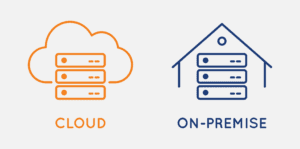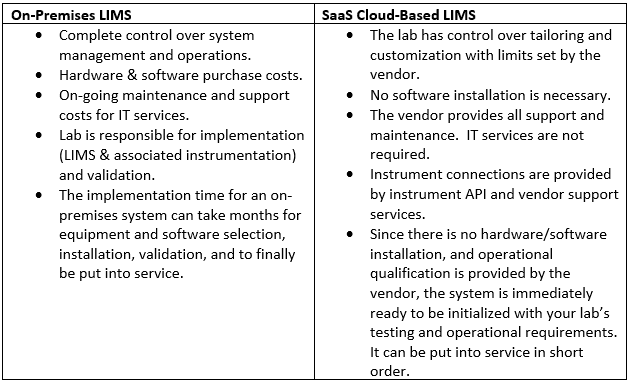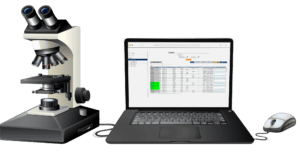Choosing a LIMS technology: Cloud-based or on-premises?

By: Joe Liscouski | April 11, 2022
 In a previous article[1], we discussed what a Laboratory Information Management System (LIMS) is. In this piece, we’re going to look at two solution hosting methods: on-premises and cloud-based (also referred to as Software-as-a-Service, SaaS), and how they can benefit you and your lab’s operations.
In a previous article[1], we discussed what a Laboratory Information Management System (LIMS) is. In this piece, we’re going to look at two solution hosting methods: on-premises and cloud-based (also referred to as Software-as-a-Service, SaaS), and how they can benefit you and your lab’s operations.
Before you consider whether one or the other is right for you, you have to define your requirements, and how you are going to use the system. Doing that shifts the discussion from an academic article to a practical and more useful read.
Some points to consider
Both approaches do the basic LIMS “things” but what about:
- Instrument connections, what types of instruments will be sending/receiving data/information from the LIMS? Do the Instrument Data System (IDS) vendors provide a mechanism for that connection? Does the instrument vendor provide any support for inter-system data transfer?
- Do you need remote access?
- Who will provide maintenance (upgrades/updates, backup)?
- What resources do you have available: IT? funding? support personnel?
- What is your desired time frame for getting a system into productive use?
Many labs simply want a tool, a system, that will help them get their work done, and not another software component that needs “care & feeding”. Others, because of their organizational structure, want a high level of control over information technology and have the resources to support it. The driving factors in making the SaaS/on-premises decision are resource utilization and availability; we’ll get into those now.
SaaS (cloud) systems and On-premises Hosting
The difference between a cloud-based and an on-premises LIMS system is where the software system is and that has significant ramifications. One of them is the level of IT support available to you.
An on-premises system requires installation, tailoring/customization (to meet your needs), validation, maintenance, updates/upgrades, backup[2], and instrument connections. Do you have the resources to do that? Is your IT support from a third party or in-house? If you mention that installation process to them do their eyes glaze over? Does your budget support those actions as an ongoing part of your lab’s operations?
SaaS LIMS implementations, using a hosting system provided and managed by the vendor avoids most of those issues. Tailoring and customization are still important to have the system reflect how you want your lab to operate (testing, results, etc.), but the rest is the responsibility of the SaaS LIMS vendor. This brings us to an initial comparison of the two implementations:

One ramification of this is that the cloud-based LIMS can be put into service much quicker than an on-premises system with an overall lower total cost of ownership. There is another point that has to do with the nature of your in-house IT operations: will corporate policies permit a database hosting computer in the lab or do all database operations have to be managed on corporate servers? If policies dictate the latter scenario, you are already in a “cloud” environment, it’s just an internal one.
External Access to the LIMS
Those few words bring the differences between the two implementations into stark contrast. On one hand, you have the lab with its instrumentation and equipment with the LIMS hardware and software on the same site[3], and on the other, you have the same facility but with the lab’s workflow database in a remote facility; physically separated but electronically and functionally just as close. The implications of those two views affect how connections are made between instrumentation, people and the LIMS.
Instrumentation
One of the advantages of a LIMS is the ability to have an instrument data system (IDS) produce results to be entered into the database. This will speed up the transfer, reduce costs (human data entry is slow and needs to be verified) and improve the overall efficiency of the operations. In addition, worklists for IDS can be generated by the LIMS and sent to the appropriate system, have the work done and then return the results electronically to the LIMS, considerably more efficient than manual work.
entry is slow and needs to be verified) and improve the overall efficiency of the operations. In addition, worklists for IDS can be generated by the LIMS and sent to the appropriate system, have the work done and then return the results electronically to the LIMS, considerably more efficient than manual work.
Those data transfers can be done through an internal network (on-premises system) or over the internet (SaaS LIMS). The biggest concerns are with instruments that have network connections (Ethernet, serial or USB) but cannot function without a direct connection to a computer. Many vendors provide hardware and software – middleware – solutions to make this connection easy to implement, be secure and reliable – like LabLynx’s LabVia solution.
Human Interaction with a LIMS
Your interaction with a LIMS would be through a standard browser on your computer, this would be the case in either of the hosting options we’re considering. The difference would be how the browser connects to the database system from a remote site. In a SaaS/cloud-based model, it is essentially like connecting to any other remote service: enter the URL, log in and go to work. Security is maintained by the vendor. Remote access to an on-premises system would have to be via mechanisms provided by your IT group that protects against unauthorized access. This difference comes into play when you consider collaboration with outside groups. The ease of access with cloud-based (under careful security controls) means that third parties can have access to LIMS functions and data (controlled by your lab’s administrator) to facilitate their work with you. Doing that through an on-premises system with corporate controls may make that more difficult.
How realistic is a Cloud-Based LIMS solution?
Modern cloud-based hosted solutions for laboratory informatics systems have progressed to the point where they are an accepted technology; one that is being widely adopted. LabLynx has been at the forefront of this technology development. The underlying communications technology – the Internet – has recently undergone significant stress testing. This piece is being written in 2022 and we’ve just been through two years of workplace stress with many people working from home and placing heavy demands on the internet. A report published by the Organization for Economic Co-operation and Development (OECD.org) entitled “Keeping the Internet Up and Running in Times of Crisis[4]”. That report concluded in part:
- “Since the start of the COVID-19 crisis, demand for broadband communication services has soared, with some operators experiencing as much as a 60% increase in Internet traffic compared to before the crisis.
- Network operators and content providers have to date successfully maintained services and efficiently utilized pre-existing capacity, and in certain cases expanded this capacity.”
The report also made recommendations for improvement in capability. We are currently seeing a significant expansion of access to the internet: speeds are increasing, reliability is improving, and the technology is maturing as 5G technology and StarLink (SpaceX) satellite access to the internet is increasing daily, making it easier for underserved users to get access. However, on a more cautious note, before embracing any Internet-based technology you should evaluate your access and make sure it meets your needs as internet access is far from uniformly distributed.
These points will become increasingly important as your organization comes to grips with potential disruptions due to climate-change-driven events (including disaster recovery), and the need for flexible working arrangements.
Security
The contents of the LIMS database represent a significant value to you and your organization, protecting it is an organizational goal. If it’s of value to you, it will be to others. The two hosting options under consideration in this note have different sets of concerns in addressing the matter. The fundamental issue is having access to your data, as you want that access while protecting it from unauthorized use. So how do they compare and what are the trade-offs?
Cloud – SaaS – Hosting:
- The vendor takes responsibility for security, your responsibility is to make sure that access ID’s/passwords are protected and that normal precautions are taken (not leaving systems unattended, careful use/distribution of access privileges, etc.). It’s a shared responsibility, prudent access on the user’s part, and system monitoring on the vendors.
- A high level of security is a business requirement for the vendor.
- The same level of security exists on-site and via remote access with responsible actions by the user.
- Adjustments for changes in personnel requirements take just a few clicks, including enabling/disabling access and permissions.
- Software monitoring is provided by a dedicated team with 24/7 threat protection.
On-premises Implementations:
- Your organization’s security processes have to cover all aspects of the business, including physical access to the facility and lab spaces, access to computers, servers, etc.
- The software has to be maintained and up-to-date for system upgrades, patches, etc.
- Potential problems resulting from employee dissatisfaction can compromise security, this can be time-consuming to track down and take corrective action.
- Security requirements place an additional load on IT personnel which may be overloaded. Threat protection depends on personnel availability and organizational priorities. If support organizations are taxed by the workload, security may not be as robust as needed.
Other Considerations:
- Availability – SaaS vendors provide a high level of availability via redundant systems and planned upgrades and modifications. On-premises systems availability can be affected by software updates, facilities infrastructure issues, corporate priorities, and personnel availability. In addition, they can be compromised by power outages and problems resulting from severe storms.
- Expenses – Cloud-based systems don’t require the cost of hardware and underlying software licenses, or the personnel costs for security monitoring, backups, etc. This can have a significant impact on a project’s return on investment and the likelihood of a successful outcome. SaaS systems provide you with control over expenses by the type of license you select.
- Customization – on-premises systems can be customized as needed, cloud systems depend on the vendor’s policies.
- Regulatory Issues – SaaS LIMS vendors should be knowledgeable and active in implementing regulatory compliance. Groups supporting on-premises systems may not be able to dedicate people to ensuring regulatory compliance promptly, or be aware of the ramifications of the regulatory requirements for lab operations.
- Data Integrity/Security – SaaS LIMS vendors place a high value on maintaining data integrity and access through redundancy in facilities and backup procedures; securing your data is a priority.
Summary:
Given the preceding material, SaaS LIMS deserves serious consideration as a candidate for a lab informatics implementation. It is particularly valuable for small companies and startups who need an informatics solution, but cannot afford the time and expense of an on-premises installation or who don’t have access to an IT support group that:
- Understands laboratory operations,
- Can manage support requirements including backup and recovery procedures daily (local and off-site), timely systems maintenance, and
- The regulatory landscape.
Larger organizations can benefit by off-loading a significant responsibility to a qualified third-party organization instead of taking on the burden of another significant software system.
Both cloud-based solutions and on-premises hosting can satisfy the technical requirements of the database systems. What we are considering here is the support, speed of implementation, and financial considerations that need to be understood before committing to a set of products and services.
LabLynx offers both cloud-based and on-premises hosting options, providing you the flexibility to host your ideal LIMS in the method that suits you best. To learn more about each hosting service, reach out to our team by clicking here or by emailing sales@lablynx.com
———————————————————————————————————————————-
[1] https://www.lablynx.com/news-events/what-is-a-lims-eln/
[2] Backup is more than copying a set of files. It requires that you have the demonstrated ability to recover a fully functioning system from that backup; a step often omitted.
[3] It may be in a different building, or potentially, another campus.
[4] https://www.oecd.org/coronavirus/policy-responses/keeping-the-internet-up-and-running-in-times-of-crisis-4017c4c9/
















